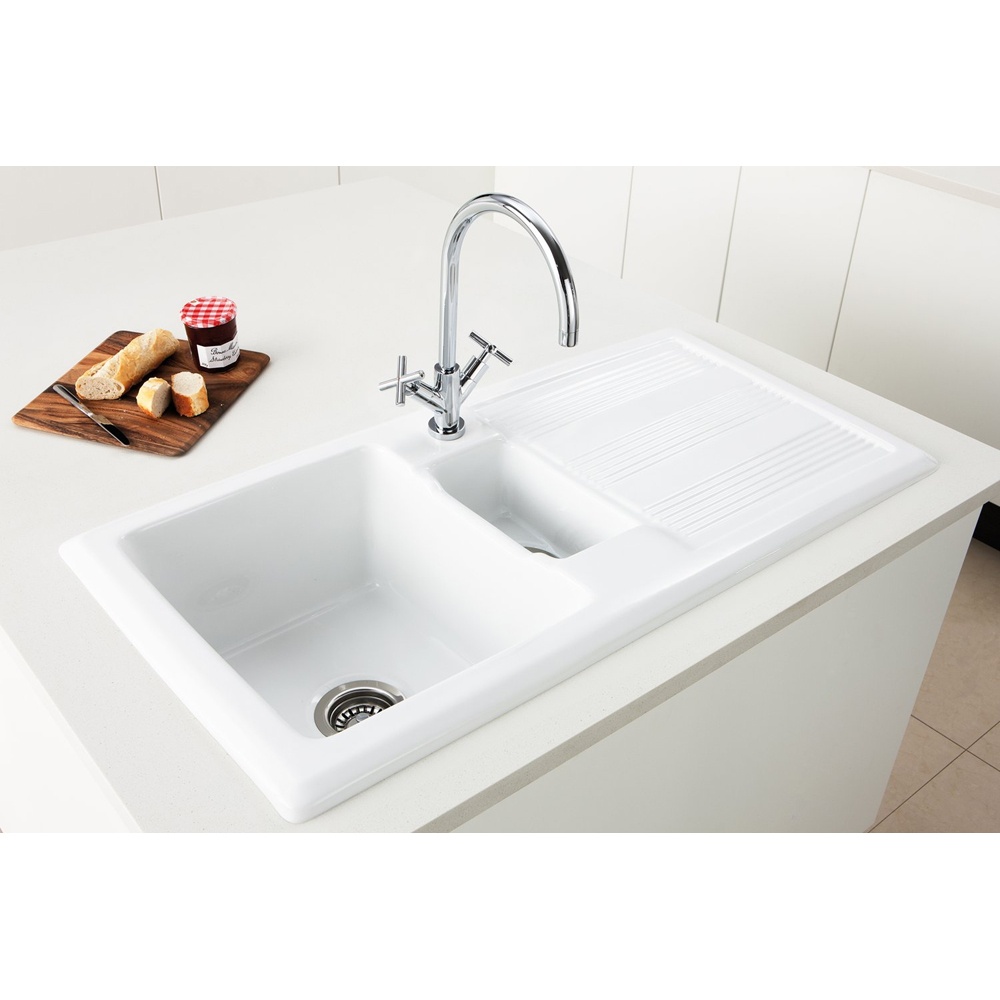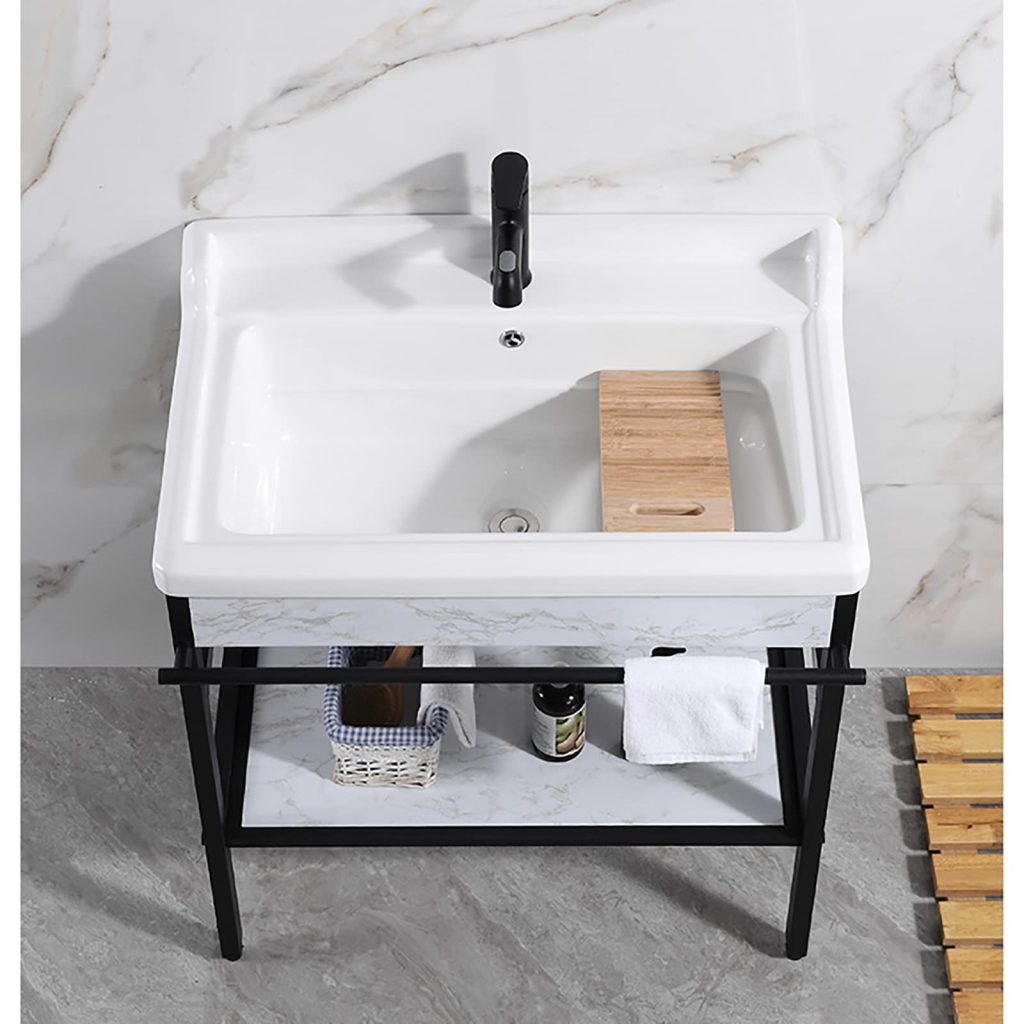Understanding the Nature of Ceramic Sinks
En 2024 how to clean ceramic sink – Are popular in many households due to their durability, aesthetic appeal, and ease of maintenance. However, understanding the nature of ceramic sinks is essential for proper cleaning and care. Ceramic is made from clay that has been fired at high temperatures, creating a hard, glossy surface resistant to stains and scratches. Despite their resilience, ceramic sinks can still suffer from dullness, discoloration, and buildup over time if not maintained correctly. Knowing what makes ceramic unique will help you choose the right cleaning methods and products, ensuring your sink remains pristine and functional for years to come.

The Importance of Regular Cleaning
Regular cleaning is crucial to keeping your ceramic sink looking its best. Daily use can lead to the accumulation of soap scum, food particles, and mineral deposits, which can dull the sink’s finish and harbor bacteria. By incorporating a consistent cleaning routine, you can prevent these issues from becoming more significant problems. Regularly cleaning your sink not only enhances its appearance but also extends its lifespan and maintains a hygienic environment in your kitchen or bathroom. A clean sink is more inviting and ensures that you and your family are using a sanitary space for food preparation and personal care.
Gathering the Right Cleaning Supplies
To clean a ceramic sink properly, you’ll need to gather the right cleaning supplies. These include a soft sponge or cloth, a non-abrasive cleaner, baking soda, white vinegar, and a mild dish detergent. Avoid using harsh chemicals or abrasive scrubbers, as these can damage the ceramic’s surface and cause permanent scratches. If you prefer natural cleaning solutions, baking soda and vinegar are excellent choices for removing stains and disinfecting without causing harm. Ensuring you have the appropriate supplies on hand will make the cleaning process more efficient and effective, protecting your sink from unnecessary wear and tear.
Preparing the Sink for Cleaning
Before you begin cleaning your ceramic sink, it’s essential to prepare it properly. Start by removing any dishes, utensils, or debris from the sink. Rinse the sink with warm water to wash away loose particles and residue. This initial rinse helps to loosen dirt and makes the subsequent cleaning steps more effective. If there are any stubborn food particles or stains, you can gently scrape them off with a plastic scraper or an old credit card. Preparing the sink sets the stage for a thorough cleaning, ensuring that your efforts yield the best possible results.
Using Mild Detergent for Daily Cleaning
For daily cleaning, a mild dish detergent is an excellent choice for maintaining the cleanliness of your ceramic sink. Apply a small amount of detergent to a soft sponge or cloth and gently scrub the entire surface of the sink, paying close attention to areas around the drain and faucet where grime tends to accumulate. The mild detergent will effectively break down grease and residue without damaging the ceramic finish. After scrubbing, rinse the sink thoroughly with warm water to remove any soap residue. Regularly using a mild detergent will keep your sink looking fresh and prevent the buildup of stubborn stains.

Tackling Stubborn Stains with Baking Soda
Despite regular cleaning, ceramic sinks can occasionally develop stubborn stains that require a bit more effort to remove. Baking soda is a versatile and gentle abrasive that can effectively tackle these tough stains. Sprinkle a generous amount of baking soda directly onto the stained areas and let it sit for a few minutes. Then, using a damp sponge or cloth, scrub the stains in a circular motion. The baking soda will help lift and remove the stains without scratching the ceramic surface. Rinse the sink thoroughly with warm water to wash away any remaining baking soda residue. This method is particularly effective for removing tea, coffee, and other common household stains.
Utilizing White Vinegar for Deep Cleaning
White vinegar is an excellent natural cleaner that can be used for deep cleaning your ceramic sink. Its acidic properties help dissolve mineral deposits, soap scum, and other residues that can accumulate over time. To use white vinegar, fill the sink with hot water and add one cup of vinegar. Let the solution sit for about 30 minutes to allow the vinegar to break down deposits. After soaking, drain the sink and scrub the surface with a sponge or cloth. For tougher spots, you can apply undiluted vinegar directly to the affected area and scrub gently. Rinse the sink thoroughly with warm water to ensure all vinegar residue is removed. Using white vinegar regularly will help keep your sink bright and free from buildup.

Removing Rust Stains with Lemon Juice
Rust stains can be particularly challenging to remove from ceramic surfaces, but lemon juice offers an effective and natural solution. The citric acid in lemon juice is strong enough to dissolve rust without damaging the ceramic. To remove rust stains, cut a lemon in half and rub the cut side directly onto the stained area. Allow the lemon juice to sit for about 10 minutes, then scrub the stain with a soft sponge or cloth. For more persistent stains, you can create a paste by mixing lemon juice with a small amount of baking soda and applying it to the rust spot. After scrubbing, rinse the sink thoroughly with warm water. This method will help restore the sink’s original shine and remove unsightly rust stains.
Addressing Discoloration with Hydrogen Peroxide
Over time, ceramic sinks may develop discoloration due to hard water deposits, food stains, or other factors. Hydrogen peroxide is a powerful bleaching agent that can help restore the sink’s original color. To use hydrogen peroxide for cleaning, pour a small amount directly onto a clean cloth or sponge and apply it to the discolored areas. Let it sit for about 15 minutes to allow the peroxide to work on the stains. Afterward, scrub the area gently and rinse thoroughly with warm water. For more extensive discoloration, you can soak a paper towel in hydrogen peroxide and place it over the stained area for a longer period before scrubbing. Regular use of hydrogen peroxide can help maintain the sink’s brightness and overall appearance.
Preventing Future Stains and Buildup
Preventing future stains and buildup in your ceramic sink requires proactive measures. One effective strategy is to rinse the sink thoroughly after each use to remove food particles, soap residue, and other debris. Drying the sink with a clean cloth after rinsing can help prevent water spots and mineral deposits from forming. Using a sink mat or grid can also protect the ceramic surface from scratches and chips caused by heavy pots and pans. Additionally, periodically applying a ceramic-friendly sealer can create a protective barrier against stains and discoloration. By incorporating these preventive measures into your routine, you can keep your sink looking clean and well-maintained.

Dealing with Scratches and Chips – how to clean ceramic sink
Despite careful maintenance, ceramic sinks can sometimes develop scratches and chips. While minor scratches can often be polished out using a fine-grit sandpaper or a specialized ceramic repair kit, deeper scratches and chips may require professional repair. To minimize the risk of scratching, avoid using abrasive cleaners or scrubbers and handle heavy items with care. If your sink does develop a chip, applying a porcelain touch-up glaze can help conceal the damage and protect the exposed area from further deterioration. Regular inspections and prompt repairs are essential for preserving the integrity and appearance of your ceramic sink.
Maintaining the Glossy Finish – how to clean ceramic sink
Maintaining the glossy finish of your ceramic sink is essential for preserving its aesthetic appeal. Regular cleaning with mild detergents and gentle scrubbing tools will help maintain the sink’s shine. Additionally, polishing the sink periodically with a non-abrasive ceramic polish can enhance its luster and provide extra protection against stains and scratches. When applying polish, follow the manufacturer’s instructions carefully and buff the sink to a high shine using a soft cloth. Avoiding harsh chemicals and abrasive materials will also help preserve the glossy finish. Consistent care and the right products will ensure that your ceramic sink remains a beautiful focal point in your kitchen or bathroom.
Cleaning the Drain and Faucet Area – how to clean ceramic sink
The drain and faucet area of your ceramic sink can accumulate grime and mineral deposits over time, requiring special attention during cleaning. Use a small brush, such as an old toothbrush, to scrub around the faucet base and drain, removing buildup that can harbor bacteria and cause discoloration. A mixture of baking soda and vinegar can be particularly effective for cleaning these areas. Apply the mixture, let it fizz and work for a few minutes, then scrub and rinse thoroughly. Regularly cleaning the drain and faucet area will prevent unsightly buildup and ensure that your sink remains hygienic and sparkling clean.
Natural Remedies for Odor Control – how to clean ceramic sink
Odor control is an important aspect of maintaining a clean and pleasant-smelling ceramic sink. Food particles and residue can contribute to unpleasant odors if not properly managed. Natural remedies, such as baking soda and vinegar, can effectively neutralize odors without the need for harsh chemicals. Sprinkling baking soda down the drain and following it with a vinegar rinse can help eliminate odors and keep your sink smelling fresh. Additionally, grinding citrus peels in the garbage disposal can impart a pleasant scent. Regularly using these natural remedies will help control odors and maintain a fresh-smelling kitchen or bathroom environment.
Final Rinse and Drying
After thoroughly cleaning your ceramic sink, a final rinse and drying step is essential to remove any remaining cleaning agents and prevent water spots. Rinse the sink with warm water to wash away any residual cleaner, baking soda, or vinegar. Then, use a clean, dry cloth or paper towel to wipe down the entire surface, ensuring it is completely dry. This step not only prevents water spots but also gives your sink a polished, streak-free finish. Taking the time to perform a final rinse and drying will leave your ceramic sink looking immaculate and ready for use.
Long-Term Care and Maintenance
Long-term care and maintenance are crucial for preserving the beauty and functionality of your ceramic sink. In addition to regular cleaning, periodically inspect your sink for signs of damage or wear, addressing any issues promptly to prevent further deterioration. Avoid placing heavy or sharp objects directly in the sink and use sink mats or grids to protect the surface. By following a consistent cleaning routine, using appropriate cleaning products, and taking preventive measures, you can ensure that your ceramic sink remains a stunning and durable fixture in your home for many years. Proper care and maintenance will keep your sink looking new and performing optimally, enhancing the overall aesthetic and hygiene of your kitchen or bathroom.



